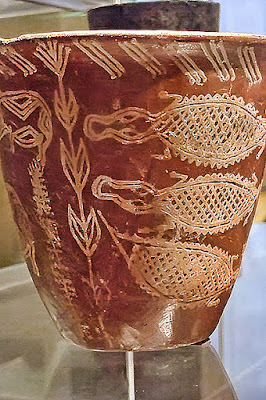A history resource article by Mary Harrsch © 2015

I just finished the first book in a new series, "Archaeology Hotspot: Egypt" by Julian Heath. The book's subtitle, "Unearthing the Past for Armchair Archaeologists" describe its target audience and, although the author has an MA in archaeology from the University of Liverpool, the book is relatively free of technical jargon and quite readable.
Heath begins by describing each period of Egypt's past then delves more deeply into archaeological activities within each period. I was particularly pleased to note that Heath gives attention to the often overlooked pre-dynastic period as well as the more widely studied Old, Middle and New Kingdoms and their associated Intermediate Periods. I was especially interested in his discussion of the Naqada Period because, not only were many of the traditions of Egypt in their embryonic stage then, but I had the opportunity to photograph Naqada pottery and unusual figurines at the Metropolitan Museum of Art and the British Museum.
 |
| Beaker with Nile River Scene Early Naqada II 3650-3500 BCE pottery predynastic Egypt. Photographed at the Metropolitan Museum of Art by Mary Harrsch © 2006 |
 |
| Female Figurines of bone and ivory Predynastic Naqada I Egypt 4000-3600 BCE. Photographed at The British Museum by Mary Harrsch © 2008. |
Heath also relates the results of a 2012 CT scan on a naturally mummified body of a young man between 18 and 20 years old from the Naqada II period (about 3400 BCE) recovered at Gebelein by Wallis Budge of the British Museum.
"The scan threw up something of a nasty surprise," Heath writes, "as it uncovered compelling evidence that Gebelein Man had been murdered with his killer catching him unawares. This evidence took the form of a stab wound in his back, just below his left shoulder blade, that had been made by a copper or flint dagger. The blow that ended Gebelein Man's life had evidently been delivered with some force, as not only had it shattered one of his ribs, causing bone splinters to become embedded into his muscles, but it also penetrated his left lung."
He also pointed out that Gebelein Man had no apparent defensive wounds.
Heath includes a number of examples like this of very recent research in this book so, despite its brevity, the reader comes away with not only a good foundation in the historical periods of Egypt and significant explorations that have revealed the development of its culture but an excellent overview of current research, including technological advances in satellite imagery, ground penetrating radar and digital analyses. It even touches on the current political and economic issues surrounding the illegal antiquities trade.
Perhaps among the most valuable inclusions in the book were the concluding passages listing museums with the largest collections of Egyptian antiquities (I didn't realize the Museum of Fine Arts Boston was among them so I have added it to my must see list!) and websites where visitors can not only view images of recovered artifacts but browse maps, plans and satellite imagery of archaeological sites and even journals kept by famous archaeologists. Heath even suggests ways to get involved with current digs. There are also extensive footnotes listed by chapter and a lengthy bibliography - a virtual handbook for any Egyptian history enthusiast.
I look forward with anticipation to the next book in this series!
 |
 |
 |
No comments:
Post a Comment